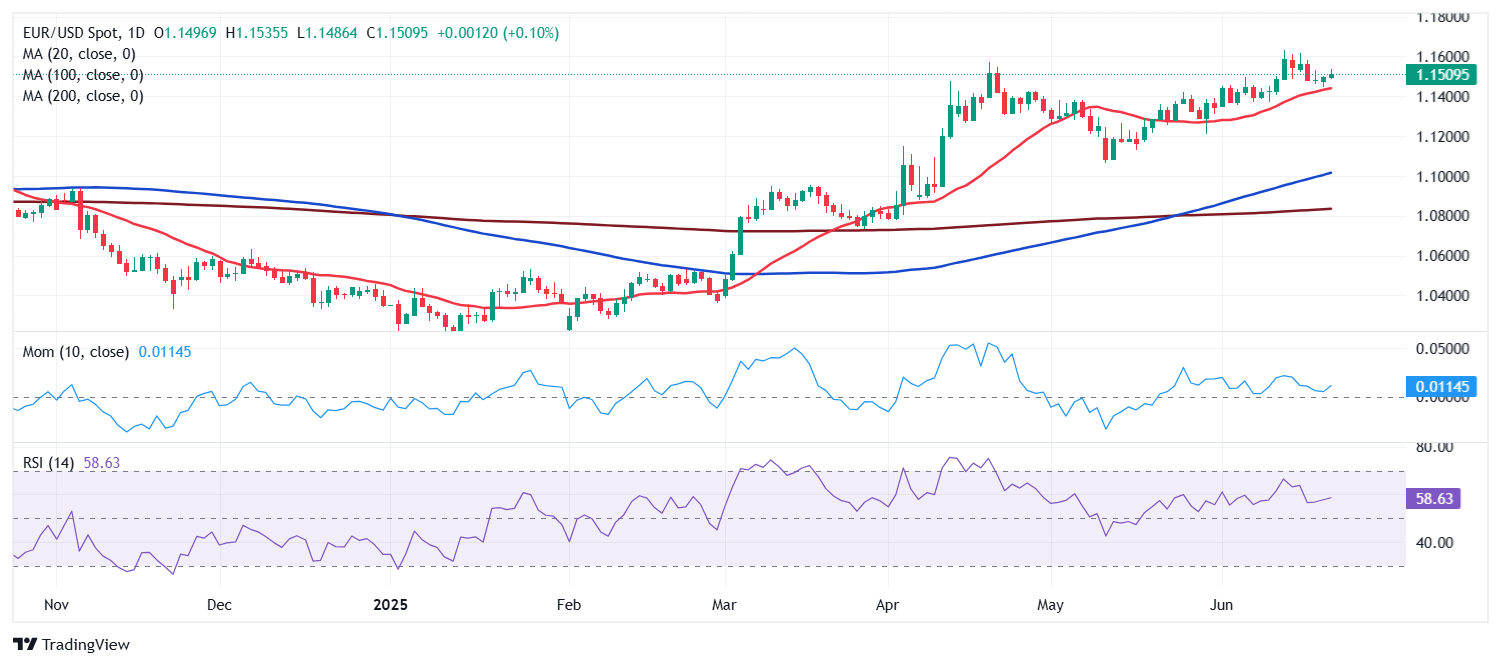
- Global trade tensions and the Middle East crisis are meant to retain the spotlight.
- Fed Chairman Jerome Powell is due to testify before Congress on Tuesday and Wednesday.
- EUR/USD aims to resume its long-term bullish run after a corrective slide from 2025 high.
The EUR/USD pair seesawed between gains and losses to end the week uneventfully at around 1.1500. Global trade tensions and the Middle East crisis kept the market sentiment on the downside, while the Federal Reserve (Fed) monetary policy announcement fell short of motivating investors.
Middle East war
Iran’s refusal to drop its nuclear program finally took its toll. Iranian Supreme Leader Ayatollah Ali Khamenei has ignored the world’s request to stop enriching uranium, in violation of its nuclear non-proliferation obligations for years. The country was on the brink of getting nuclear weapons, and neighbour Israel decided it was time to intervene.
Israel launched its first air strikes on the Iranian uranium enrichment facility at Natanz on June 12, also targeting military leaders. Iran quickly retaliated, kicking off a continued exchange of airstrikes with government, health and civilian buildings destroyed and casualties on both sides.
Things escalated when United States (US) President Donald Trump jumped into the conflict by stating the US has full control of Iranian airspace and suggesting the world’s largest economy is ready to intervene. Trump also stated that he aims for a “real” solution, diminishing the odds for a peaceful solution, but instead suggesting the US could join Israel in attacking nuclear facilities in Iran. The focus is on the Fordow nuclear site, a centrifuge facility sitting 300 feet below the surface, which the Israeli firepower seems unable to reach without the US help.
North Korea condemned Tel Aviv’s actions and warned the US and Western countries not to intervene further. Still, US President Trump is said to have approved attack plans for Iran but was holding off in the hopes that Tehran would give up its nuclear programme.
Global trade talks continue without meaningful progress
Negotiations between the US and major trade counterparts remain in the air, despite the looming July 9 deadline. US President Trump announced massive retaliatory tariffs in early May, but quickly established a 90-day pause, aiming to reach more suitable trade deals.
Talks between the US and the European Union (EU) are stuck, as President Trump reported, saying he does not “feel that they are offering a fair deal.” Should the current situation continue, US 50% tariffs on EU imports and EU countermeasures will come into effect in a couple of weeks.
A similar situation exists between the US and Japan. Meanwhile, Canada prepares countermeasures against the US 50% tariffs on steel and aluminium imports. In the upcoming days, trade-war-related concerns are likely to return to financial markets and hit sentiment.
Federal Reserve decision
The Fed left the policy rate unchanged at the range of 4.25%-4.5% as expected, following the June policy meeting. The announcement was widely anticipated, having no actual impact on the USD. Policymakers also presented a fresh Summary of Economic Projections (SEP), which showed they still see a 50 basis points (bps) reduction in the policy rate in 2025 but now forecast only a 25 bps cut in 2026, against the 50 bps projected in March’s SEP. Additionally, policymakers downgraded their growth forecast, while anticipating a higher unemployment rate and PCE inflation.
Still, Chairman Jerome Powell did as usual and poured cold water on markets. Powell came out with a quite hawkish stance in the press conference, noting the labour market has been broadly in balance and is not a source of inflation, while adding concerns related to tariffs’ impact on the economy have diminished. He also welcomed three months of favorable inflation readings and noted the economy has been resilient. Finally, he reiterated that the monetary policy is modestly restrictive and said the current policy stance leaves policymakers well positioned, showing no rush to move one way or the other. Financial markets showed little reaction to the news, with the USD temporarily firmer on the news.
By the end of the week, Fed Governor Christopher Waller said that he doesn’t expect tariffs to boost inflation significantly, adding policymakers could lower interest rates as early as July, in a CNBC interview. Waller added that not cutting rates risks a potential slowdown in the labour market.
European Central Bank paves the way for no more rate cuts
Meanwhile, European Central Bank (ECB) officials continued to pave the way for no more rate cuts. President Christine Lagarde anticipated that the monetary loosening cycle has nearly concluded following the central bank’s meeting in early June. Back then, officials delivered the eighth consecutive rate cut, lowering the deposit facility rate to 2%. Lagarde repeated multiple times that they are “well positioned,” implying no more rate cuts are needed at the time being.
Throughout the week, different officials hit the wires, aligned behind Lagarde. Some sounded more optimistic, like Spaniard Luis de Guindos, who noted the bloc’s economy had proven resilient, and German Bundesbank President Joachim Nagel, who stated officials are on the right track when it comes to monetary policy, adding rates are now in neutral territory.
Others were more cautious, like Governing Council member Mario Centeno, who expressed concerns about the economic health. “We need a stronger economy to be compatible with 2% inflation, that’s my main position,” Centeno declared.
At the end, the shift towards a more dovish ECB stance was barely enough to prevent the Euro (EUR) from running north, yet not enough to weigh on EUR/USD as the battered USD remains away from investors’ radar.
US calendar hitting up
In the last few days and beyond the Fed’s announcement, the macroeconomic calendar had little to offer. Germany published the ZEW Survey on Economic Sentiment, which improved in the country to 47.5 in June from the 25.2 posted in May. The EU index also resulted upbeat, surging to 35.3 from the previous 11.6.
The US published May Retail Sales, which fell by 0.9%, worse than the previous 0.1% decline, and the Philadelphia Fed Manufacturing Survey, which resulted at -4 in June, matching the May reading yet worse than the -1 expected.
Coming up next, the Hamburg Commercial Bank (HCOB) and S&P Global will release the preliminary estimates of the June Purchasing Manager Indexes (PMI) for all major economies on Monday. Fed Chair Jerome Powell will testify about the Semiannual Monetary Policy Report before different congressional committees on Tuesday and Wednesday. The first day tends to be the most relevant, as his words could bring some fresh clues on the Fed’s thinking. On Thursday, the US will release the final estimate of the Q1 Gross Domestic Product (GDP). Finally, the country will report the Fed’s favorite inflation figure on Friday, the May Personal Consumption Expenditures (PCE) Price Index.

EUR/USD technical outlook
From a technical point of view, the EUR/USD pair lost upward momentum but remains far from bearish. The weekly chart shows that the pair remained contained within its previous week’s range, while technical indicators retreated from overbought readings. Indicators offer neutral-to-bearish slopes yet remain well above their midlines. At the same time, the pair is far above a bullish 20 Simple Moving Average (SMA) currently at around 1.1050. Finally, the 100 and 200 SMAs converge directionless in the 1.0830 area, reflecting the pause in the bullish run.
The daily chart shows the risk skews to the upside. Technical indicators aim higher within positive levels, while a bullish 20 SMA provides support at around 1.1435. Meanwhile, a bullish 100 SMA keeps advancing beyond a modestly positive 200 SMA. The latest downward move from the yearly peak at 1.1631 seems a corrective decline, with buyers getting ready to resume the bullish push.
Near-term support lies around 1.1470, ahead of the mentioned 20-day SMA at 1.1435. A bearish breakout exposes the mid-1.13, while a slide towards the 1.1300 threshold could attract buyers. Beyond 1.1560, EUR/USD could retest the year high, en route to the 1.1700 level.

Tariffs FAQs
Tariffs are customs duties levied on certain merchandise imports or a category of products. Tariffs are designed to help local producers and manufacturers be more competitive in the market by providing a price advantage over similar goods that can be imported. Tariffs are widely used as tools of protectionism, along with trade barriers and import quotas.
Although tariffs and taxes both generate government revenue to fund public goods and services, they have several distinctions. Tariffs are prepaid at the port of entry, while taxes are paid at the time of purchase. Taxes are imposed on individual taxpayers and businesses, while tariffs are paid by importers.
There are two schools of thought among economists regarding the usage of tariffs. While some argue that tariffs are necessary to protect domestic industries and address trade imbalances, others see them as a harmful tool that could potentially drive prices higher over the long term and lead to a damaging trade war by encouraging tit-for-tat tariffs.
During the run-up to the presidential election in November 2024, Donald Trump made it clear that he intends to use tariffs to support the US economy and American producers. In 2024, Mexico, China and Canada accounted for 42% of total US imports. In this period, Mexico stood out as the top exporter with $466.6 billion, according to the US Census Bureau. Hence, Trump wants to focus on these three nations when imposing tariffs. He also plans to use the revenue generated through tariffs to lower personal income taxes.
Information on these pages contains forward-looking statements that involve risks and uncertainties. Markets and instruments profiled on this page are for informational purposes only and should not in any way come across as a recommendation to buy or sell in these assets. You should do your own thorough research before making any investment decisions. FXStreet does not in any way guarantee that this information is free from mistakes, errors, or material misstatements. It also does not guarantee that this information is of a timely nature. Investing in Open Markets involves a great deal of risk, including the loss of all or a portion of your investment, as well as emotional distress. All risks, losses and costs associated with investing, including total loss of principal, are your responsibility. The views and opinions expressed in this article are those of the authors and do not necessarily reflect the official policy or position of FXStreet nor its advertisers. The author will not be held responsible for information that is found at the end of links posted on this page.
If not otherwise explicitly mentioned in the body of the article, at the time of writing, the author has no position in any stock mentioned in this article and no business relationship with any company mentioned. The author has not received compensation for writing this article, other than from FXStreet.
FXStreet and the author do not provide personalized recommendations. The author makes no representations as to the accuracy, completeness, or suitability of this information. FXStreet and the author will not be liable for any errors, omissions or any losses, injuries or damages arising from this information and its display or use. Errors and omissions excepted.
The author and FXStreet are not registered investment advisors and nothing in this article is intended to be investment advice.








